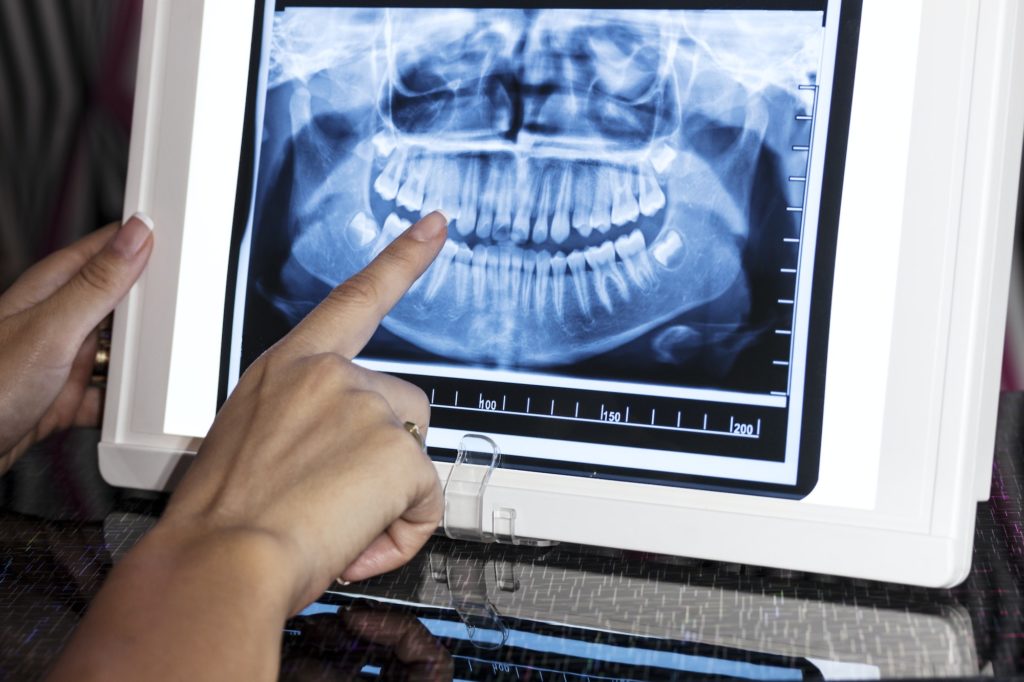Understanding the Importance of Dental X-Rays in Maintaining Oral Health

Dental X-rays, also known as radiographs, are pictures of your teeth. They are used for your dentist to get a better understanding of your teeth and mouth. Your dentists may use X-rays to get a closer look at the inner side of your teeth and gums.
Table of Contents
Think about dental X-rays as a way for your dentist to see all those small and hard-to-see areas. Another great thing about x-rays is that they help catch issues early on before they can get complicated or painful. Since it can show details inside of your bones and teeth, it can catch a decaying tooth in the early stages, before it starts breaking down your pulp, or give us a glimpse at the nerves that could be causing you pain or discomfort. It’s best to catch tooth decay at the early stages before it becomes a more serious issue like a dead tooth.
Are Dental X-rays Safe?
Many people have concerns about x-rays because it involves radiation, but there is no reason to worry since the radiation levels are very low. There is also protective gear that will be provided by your x-ray technician or dentist. X-rays are safe for children and adults, but if you aren’t a fan of a traditional x-ray, some dentists now have digital x-rays too!
What Are Precautions the Dentist Will Take to Keep You Safe?
Even though you are safe from radiation, here are some precautions your dentist will take to ensure maximum safety.
- A lead “bib” placed over your chest, abdomen, and pelvic region to prevent unnecessary radiation exposure to your vital organs.
- A thyroid collar may be used in the case of thyroid conditions.
Women who are pregnant are supposed to avoid all types of X-rays because the radiation could be harmful to developing your fetus.
Why are Dental X-rays Needed?
X-rays help your dentist see things they could never see with the naked eye. They can see things like the condition of your teeth, your roots, and even your jaw and facial bone condition. An X-ray is also a great tool for catching problems early and preventing issues you may be more susceptible to.
Here are some of the helpful things an x-ray can help to discover:
- Tooth decay (This is great for tiny areas of your mouth that can’t be seen as well)
- Position of teeth (this helps your dentist with tooth implants, braces, and dentures )
- Loss of bone in the jaw
- Changes in the bone from infection.
- Abscesses (an infection in the tooth root or in between the gum and a tooth).
- Catching tumors early on
It is pretty standard to get an X-ray at the beginning of your dental appointment. As mentioned, it’s very safe and there is little to no reason to worry. The radiation exposure levels are extremely low and you get a protective lead bib to cover you and all your vital organs. Plus it only takes a few seconds and a few angles, and your dentist will have a detailed up-close picture of what’s happening around and inside your teeth! From there, they can find everything to keep you and your smile healthy!
Types of Oral Cancers Detectable with X-Rays
While dental X-rays are primarily used to identify cavities, bone loss, and other dental issues, they can also help detect certain types of oral cancers. X-rays can reveal abnormalities such as unusual bone erosion, masses, or lesions that may indicate the presence of cancerous or precancerous conditions. Some types of oral cancers that may be identified through X-rays include:
Squamous Cell Carcinoma – The most common type of oral cancer, which can appear as a mass or lesion in the soft tissues of the mouth or jaw.
Osteosarcoma – A type of bone cancer that affects the jawbone and may show up on X-rays as irregular bone growth or destruction.
Metastatic Cancer – In some cases, cancers from other parts of the body (such as the lungs or breasts) can spread to the jawbone, and dental X-rays may reveal these secondary tumors.
While X-rays alone cannot confirm cancer, they provide valuable information that helps dentists identify suspicious areas that may require further testing, such as biopsies or advanced imaging techniques like CT scans or MRIs.
Dental X-rays FAQs
A dental X-ray is a diagnostic tool to capture images of teeth, gums, and surrounding structures. It involves using low radiation levels to produce detailed images that help dentists evaluate oral health conditions that may not be visible to the naked eye. Dental X-rays provide valuable information about tooth decay, bone loss, infections, impacted teeth, and other dental issues. They are essential for accurate diagnosis and treatment planning, allowing dentists to detect problems early on and provide appropriate care. Dental X-rays are generally safe, with minimal radiation exposure, and are integral to maintaining good oral health.
Dental X-rays are recommended for individuals of all ages, but the frequency and necessity may vary depending on each person’s oral health and specific circumstances. Generally, dentists determine the need for X-rays based on factors such as a patient’s dental history, age, risk of oral diseases, and symptoms they may be experiencing. Routine dental X-rays are often advised for new patients to establish a baseline and for regular check-ups to monitor any changes in oral health.
Additionally, X-rays are crucial for identifying and diagnosing dental problems such as tooth decay, gum disease, impacted teeth, and infections. Dentists use their professional judgment to determine the appropriate timing and frequency of dental X-rays to ensure their patients’ best care and treatment.
Dental X-rays can detect oral health conditions that may not be visible during a routine dental examination. They provide valuable information about tooth and bone health, allowing dentists to diagnose and treat dental issues effectively. Dental X-rays can detect tooth decay, including hidden cavities between teeth, under fillings, or beneath the gum line. They can also reveal infections such as abscesses, cysts, or tumors in the jawbone. X-rays help dentists assess the health of the tooth roots, identify bone loss due to gum disease, and evaluate the alignment and positioning of teeth. Additionally, dental
X-rays are instrumental in diagnosing problems like impacted teeth, fractures, and abnormalities in the jawbone or sinus areas. Dentists can provide appropriate treatment and prevent further complications by detecting these issues early on.
The frequency of dental X-rays depends on individual factors such as your oral health, dental history, and risk factors for oral diseases. Dental X-rays are typically recommended for most individuals with good oral health every 1 to 2 years. However, suppose you have a history of dental problems, such as a high risk of cavities or gum disease or experiencing symptoms like tooth pain or swelling. In that case, your dentist may recommend more frequent X-rays to monitor and diagnose potential issues.
Children and teenagers may require X-rays more often as their teeth and jaws are still developing. Ultimately, the decision about the timing and frequency of dental X-rays is made by your dentist, who will consider your specific circumstances to ensure optimal oral health and safety.
